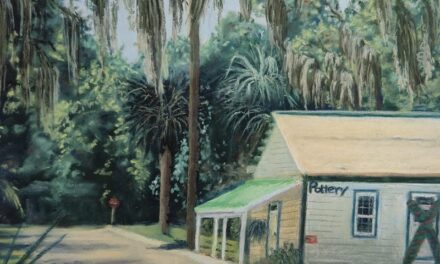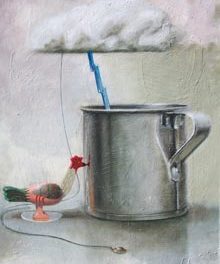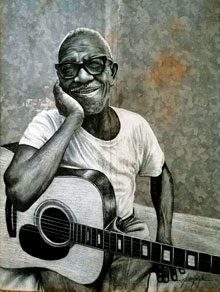 Fleetwood Covington’s Blues Soaked Art Comes to USCB
Fleetwood Covington’s Blues Soaked Art Comes to USCB
By Mark Shaffer
I knew of Fleetwood Covington long before I finally met him prior to his 2015 show at the Thibault Gallery on Bay Street. Mostly I knew of him through his brother Vince as well as his sister-in-law – my longtime Lowcountry Weekly colleague – Debbi Covington. “Fleetwood’s quite a character,” she told me. I figured he had to be with a name like Fleetwood. I mean, how many Fleetwoods do you meet in life? And as if that were not enigmatic enough, in addition to being an artist with a considerable following, he’s also a musician, songwriter and Blues fanatic.

His subjects run the gamut from modern rockers to old blues icons, to movie stars, motorcycles and mules – or as he told me back then, “Whatever’s cool.” His work is collected by Rock & Roll Hall of Famers and some of Hollywood’s most elite, although decorum prohibits any name dropping here.
For his upcoming show at USCB he’s once again selected an eclectic collection of work. Much of that work involves painstakingly detailed “photo impressionistic” images rendered on salvaged tin. The show opens March 8th at the USCB Center for the Arts with a reception from 5:30 to 7:30. The artist’s sister-in-law and Lowcountry Weekly’s food columnist, Debbi Covington, will cater the event.
FULL METAL FLEETWOOD
Mark Shaffer: What can we expect this time?
Fleetwood Covington: It’s going to be a hodgepodge, man. I’m not going to stick to one genre. I’m bringing [drawings of] motorcycles, I’m bringing some of the Delta [Blues] Exhibit. I did an exhibit of 52 pieces and kept about nine of them. And I’m going to bring some tin, but 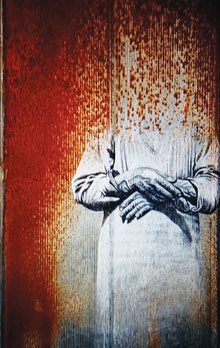 some strange pieces of tin.
some strange pieces of tin.
MS: That sounds intriguing.
FC: I’m not trying to be pretty with it, you know? I don’t have anything shocking, but there’s some cool stuff. There was famous crime photographer in New York in the ‘40’s and ‘50’s called himself Weegee (Arthur Fellig) and published a book called Naked City. Well, my dad had an original copy when we were growing up and that book kind of warped me, I guess.
MS: That’s really grim stuff. It’s basically a book full of murder victims.
FC: Yeah and all in black and white. It scared the s*** out of me (laughs). But there’s a shot of this mugger who used to terrorize Central Park for about two years before they caught him. It looks like he’s sitting up in this shot but it’s actually just this garb, this freaky costume that he wore with welder’s goggles. This piece is on an iron door that I found in a junkyard in Wilmington. It looks gnarly. Wait till you see it. I’ve had a few people who know Weegee’s book and ask if it’s from Naked City. I’ve always wanted to do a series on it.
MS: How would you categorize your work to someone who’s never seen it?
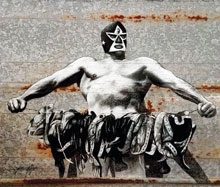 FC: Raw but to the point. And like I’ve said before, I don’t like naming stuff. I like to leave the visual interpretation totally to the viewer. That’s why I like working from photographs. I can make it up all day long, but it just seems hollow to me. I like stuff that was, that actually happened. It has more of a life to it – more of a pictorial ethereal energy, if you will.
FC: Raw but to the point. And like I’ve said before, I don’t like naming stuff. I like to leave the visual interpretation totally to the viewer. That’s why I like working from photographs. I can make it up all day long, but it just seems hollow to me. I like stuff that was, that actually happened. It has more of a life to it – more of a pictorial ethereal energy, if you will.
MS: Your fascination with the culture of The Blues has been a huge influence.
FC: Yeah. They were all national treasures that died dirt poor. It took the British Invasion in the mid ‘60’s to bring it back to us in a form we could understand with white guys playing it, you know?
I’ve always liked it because it’s unlearned and raw but it’s got more soul than anything. It’s like Folk Art. I love Folk Art. I once saw these two little straw sculptures. One was a male, the other was a female, both were about six inches tall. One was pre-Ming Dynasty China and the other was 1940’s Appalachia. If you had them side by side it looked exactly like the same person made them. And that’s kind of why I like The Blues so much. You’ve got these Delta dudes who’ve barely got an idea of how to tune a guitar, but they’re pouring their feelings out with it. To be able to do something that strong is amazing. You can’t stop creativity. You can’t even stifle it. Not true creativity.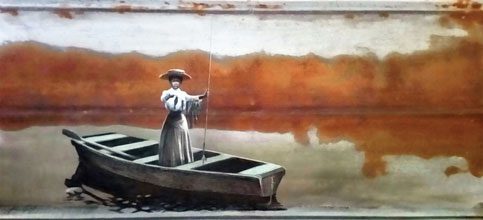
The Impressionist Era in Paris in the late 1800’s was a bloom of art, an explosion of creativity. A similar thing happened not a hundred years later in the Mississippi Delta, this 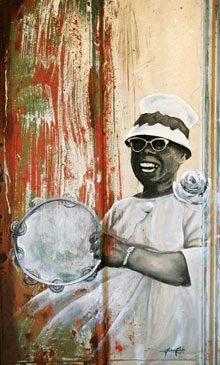 bloom of creativity. But it was not recognized at the time. It was a struggle all the way with all the restraints and prejudices, yet that form was able to squeeze through all that s*** man, and become a driving force in music. And probably 99 percent of Americans who like blues have absolutely no idea of how it started and the forgotten masters of it like Bukka White, Furry Lewis, Charley Patton and Blind Willie Johnson.
bloom of creativity. But it was not recognized at the time. It was a struggle all the way with all the restraints and prejudices, yet that form was able to squeeze through all that s*** man, and become a driving force in music. And probably 99 percent of Americans who like blues have absolutely no idea of how it started and the forgotten masters of it like Bukka White, Furry Lewis, Charley Patton and Blind Willie Johnson.
MS: You do a lot of work on tin. What’s the attraction?
FC: I still do a lot of canvas work and drawings. And, Mark, a lot of stuff that I do never gets seen. I’ve got a lot of clients and all they want is a one of a kind. They’re my collectors and they don’t want anybody to have a copy. And that’s sort of what this show is about. I’m taking a lot of stuff I normally wouldn’t take.
But I like the tin because of the immediacy of a feeling in a way. It amps the piece into an artifact, so to speak, if it’s done right. I’m an artist. It’s the struggle and the complication and the challenge for me. Canvas? You pretty much know what that surface is going to be. It’s the same every time. I got into tin about 15 years ago with the House of Blues. They wanted me to do a show with blues characters and I thought, what better way to do it than on tin?
With tin each surface is a different surface and a unique challenge. I like that challenge  because I get complacent with a lot of stuff. I guess it’s my ADD kicking in.
because I get complacent with a lot of stuff. I guess it’s my ADD kicking in.
MS: Is that a good thing?
FC: Sometimes. Sometimes because it keeps you looking. Complacency is the worst thing that can happen to an artist. If I’m halfway through a piece and I feel the battle’s won, it’s like, call in the clean-up crew. Then it’s hard to finish. I feel as I get older, it gets harder to finish things. That’s why a lot of artists are abstract. They can quit at any point. It’s like [Jackson]Pollack. Someone asked him, “How do you know when you’re finished?” And he said, “How do you know when you’re done making love?” The thrill is gone, man. The thrill is gone.
Meet the artist at USCB’s Center for the Arts, Thursday March 8th from 5:30-7:30 with Catering by Debbi Covington.


